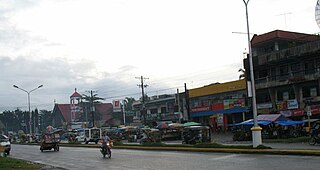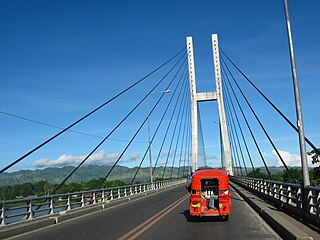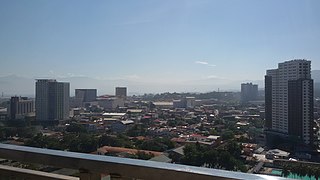
Mindanao is the second-largest island in the Philippines, after Luzon, and seventh-most populous island in the world. Located in the southern region of the archipelago, the island is part of an island group of the same name that also includes its adjacent islands, notably the Sulu Archipelago. According to the 2020 census, Mindanao has a population of 26,252,442 people, while the entire island group has an estimated population of 27,021,036 according to the 2021 census.
The military history of the Philippines is characterized by wars between Philippine kingdoms and its neighbors in the precolonial era and then a period of struggle against colonial powers such as Spain and the United States, occupation by the Empire of Japan during World War II and participation in Asian conflicts post-World War II such as the Korean War and the Vietnam War. The Philippines has also battled a communist insurgency and a secessionist movement by Muslims in the southern portion of the country.

Agusan del Sur, officially the Province of Agusan del Sur, is a province in Caraga region, Mindanao, Philippines. Its capital is the municipality of Prosperidad. It is bordered on the northwest by Agusan del Norte and Misamis Oriental; east by Surigao del Sur; southeast by Davao Oriental; mid-south by Davao de Oro; southwest by Davao del Norte and, mid-west by Bukidnon. It is the fourth largest province in the country in terms of area.

Surigao del Norte, officially the Province of Surigao del Norte, is a province in the Philippines located in the Caraga region of Mindanao. The province was formerly under the jurisdiction of Region 10 until 1995. Its capital is Surigao City. The province comprises two major islands—Siargao and Bucas Grande—in the Philippine Sea, plus a small area at the northeastern tip of mainland Mindanao and other surrounding minor islands and islets. This mainland portion borders Agusan del Norte – between the Municipality of Alegria in Surigao del Norte and the Municipality of Kitcharao in Agusan del Norte; and the province of Surigao del Sur, to the south.

Butuan, officially the City of Butuan, is a 1st class highly urbanized city in the region of Caraga, Philippines. It is the de facto capital of the province of Agusan del Norte where it is geographically situated but has an administratively independent government. According to the 2020 census, it has a population of 372,910 people.

Magallanes, officially the Municipality of Magallanes, is a 4th class municipality in the province of Agusan del Norte, Philippines. According to the 2020 census, it has a population of 22,293 people.

Nasipit, officially the Municipality of Nasipit, is a 3rd class municipality in the province of Agusan del Norte, Philippines. According to the 2020 census, it has a population of 44,822 people.

Butuan Bay is a bay and extension of the Bohol Sea or Mindanao Sea, in the northeast section of Mindanao in the Philippines. Its main river source is the Agusan River, which empties into the bay at the coastal city of Butuan. Butuan Bay is completely contained with the Agusan del Norte province.

Radio Mindanao Network, Inc. (RMN), d.b.a. RMN Networks or RMN Network, is a Filipino media company based in Makati, Philippines. It is primarily involved is one of the largest radio networks. Its corporate office is located at the 4th Floor State Condominium I Bldg, Salcedo St., Legaspi Village, Makati, and its main headquarters are located at the RMN Broadcast Center, Don Apolinario Velez St., Cagayan de Oro.

From 1986 to 1987, there were several plots to overthrow Philippine President Corazon Aquino involving various members of the Armed Forces of the Philippines. A significant number of the military participants in these attempts belonged to the Reform the Armed Forces Movement (RAM), while others were identified loyalists of former President Ferdinand Marcos, who had been deposed in the People Power Revolution in late February 1986.
The most serious attempted coup d'état against the government of Philippine President Corazon Aquino was staged beginning December 1, 1989, by members of the Armed Forces of the Philippines belonging to the Reform the Armed Forces Movement (RAM) and soldiers loyal to former President Ferdinand Marcos. Metro Manila was shaken by this Christmas-time coup, which almost seized the Malacañang Palace. It was completely defeated by the Philippine government by December 9, 1989.

Cagayan de Oro (CDO), officially the City of Cagayan de Oro, is a 1st class highly urbanized city in the region of Northern Mindanao, Philippines. It is the capital of the province of Misamis Oriental where it is geographically situated but governed administratively independent from the provincial government. According to the 2020 census, it has a population of 728,402 people. Cagayan de Oro also serves as the regional center and business hub of Northern Mindanao, and part of the growing Metropolitan Cagayan de Oro area, which includes the city of El Salvador, the towns of Opol, Alubijid, Laguindingan, Gitagum, Lugait, Naawan, Initao, Libertad and Manticao at the western side, and the towns of Tagoloan, Villanueva, Jasaan, Claveria and Balingasag at the eastern side.
1987 in the Philippines details events of note that happened in the Philippines in the year 1987.
1990 in the Philippines details events of note that happened in the Philippines in the year 1990.

The Federal Republic of Mindanao was a short-lived, self-proclaimed, unrecognized breakaway state encompassing Mindanao, Palawan and the Sulu Archipelago of the Philippines. The independence of the republic was to be proclaimed at a convention in Cagayan de Oro on April 25, 1986, by the Mindanao People's Democratic Movement led by Reuben Canoy but original plans to proclaim the proposed republic's independence were changed to avert arrest by the Corazon Aquino administration due to violation against sedition law. A 31-paged constitution was signed as a move to declare intent to proclaim an independent federal state and the flag of the proposed state was raised. Mindanao, Land of Promise and Security, is the proposed national anthem by the proposed country's proponents.
The siege at Hotel Delfino in Tuguegarao, Cagayan in the Philippines, took place on March 4, 1990. A private army estimated at 300 men seized the hotel under the command of suspended Cagayan governor Rodolfo "Agi" Aguinaldo, a fierce critic of the administration of President Corazon Aquino and the Communist insurgency in the Philippines. The incident was an offshoot of the 1989 Philippine coup d'état attempt that Aguinaldo publicly supported, which led to his suspension and arrest. The standoff ended violently after several hours, leaving 14 people dead, including a high-ranking general who tried to arrest him.

The Butuan–Cagayan de Oro–Iligan Road, or Butuan–Cagayan de Oro–Iligan–Tukuran Road, is a 416-kilometer (258 mi), two-to-six lane major thoroughfare, connecting the provinces of Agusan del Norte, Misamis Oriental, Lanao del Norte, and Zamboanga del Sur.

The Mindanao Railway, previously known as the Trans-Mindanao High Speed Railway, is a proposed inter-city rail system in Mindanao, the southernmost major island of the Philippines. Originally proposed in 1936 as part of Manuel L. Quezon's efforts to strengthen the presence of Commonwealth government in Mindanao against the rising influence of Imperial Japan before World War II, the line was shelved. Other proposals and studies were made in the 1950s, 1990s, and the 2000s, but never materialized. The current line began development in 2018, with construction set to begin in late 2021. It will be initially built as a single-track standard gauge system to be operated by diesel-powered rolling stock, but will have provisions for upgrading to double-track and electrification through overhead lines.
Camp Edilberto Evangelista is a military installation of the Philippine Army in Cagayan de Oro, Philippines.
Reuben Rabe Canoy was a Filipino lawyer, commentator and advocate of federalism who served as mayor of Cagayan de Oro and legislator in the 1970s and 1980s.













